Relative dating is a crucial tool in roughly ordering artifacts or sites into sequences. Archaeologists utilize many different sequencing techniques, depending on the site or the questions they want answered. These include stratigraphy, typological sequences, and environmental sequences.
Environmental sequences can include deep-sea cores, ice cores, and pollen dating. Deep-sea cores are used to mark climatic change most accurately for the last 2,000-3,000 years (Renfrew 2007, 115). When dealing with time periods farther back, pollen dating is most useful. Pollen grains are incredibly durable, lasting for millions of years, and aid in our comprehension of ancient environments.
Northern Europe, specifically Neumark-Nord near Halle, Germany (Aridi 2021), and Western and Central Asia (Figure 1) were home to Neanderthals (Monnier 2012). Neanderthals lived “from about 400,000 to 30,000 years ago” (Renfrew 2007, 135 ). During that time period, those regions saw some of the coldest conditions ever experienced, evidenced by the shorter limbs and broader chests of Neanderthals (Figure 2) specifically adapted to withstand colder temperatures (Monnier 2012). Neanderthals survived several ice ages, and their effects on Neanderthals can be studied using relative dating.
A research team from the Max Planck Institute for Evolutionary Anthropology conducted a study on how shifting environmental conditions affected human presence, focusing on a former lakeshore in Lichtenburg, Northern Germany (Max Planck Society 2022). The team used several archaeological methods, including pollen dating to uncover the aforementioned relationship. Stone tools were discovered at the campsite and their evolution was aligned with changing environmental conditions. The study resulted in accurate dating of an interglacial period (Brörup Interstadial), and connecting a cooling period to climate change in the Greenland ice and North Atlantic, a relationship that had previously only been speculated.
The Neanderthals of Northern Europe not only evolved and adapted their tools to suit their surrounding environment, but directly altered their environment. In Lichtenberg, research aiming to answer if Neanderthals were well adapted to colder temperatures, showed that the Neanderthals repeatedly visited Northern Central Europe, even during the last Ice Age. This region developed from a heavily forested area, to sparser forests, to cold tundra (Max Planck Society 2022). A different team, led by archaeologist Wil Roebroeks, sought to explain how the region changed from forest to a relatively open space. The study involved pollen dating and charcoal sampling to piece together how fire was utilized, with the wood and seeds found. This connection allowed researchers to speculate that the phenomenon of humans clearing land for fields occurred much earlier than once thought. This revolutionary discovery shows the oldest known evidence of “hominids reshaping their environment” (Aridi 2021).
Environmental sequences have provided a way of looking into the past when radiocarbon dating fails. Although it is not as accurate or widely used as radiocarbon, it is crucial in our understanding of early time periods.
References:
Aridi, Rasha
12/17/21 Scientists Find the Oldest Evidence of Neanderthals Altering the Natural Landscape. Smithsonianmag.com. https://www.smithsonianmag.com/smart-news/scientists-find-the-oldest-evidence-of-ancient-humans-altering-the-natural-landscape-180979251/
Max Planck Society
4/26/22 Neanderthals of the North reveal tolerance of humans to changing environmental conditions. Phys.org. https://phys.org/news/2022-04-neanderthals-north-reveal-tolerance-humans.html
Monnier, Gilliane
2012 Neanderthal Behavior. Nature.com. https://www.nature.com/scitable/knowledge/library/neanderthal-behavior-59267999/
Renfrew, Colin
2018 When? Dating Methods and Chronology. In Archaeology Essentials: Theories/Methods/Practice. 4th edition. pp. 115-135. Thames & Hudson, London, England
Links of interest:
https://www.sciencedirect.com/science/article/abs/pii/S0920544608700773
https://www.sciencedirect.com/science/article/pii/S0277379122001500?via%3Dihub



What are some of the limitations of environmental sequencing? What information might we be lacking about past environments?
Environmental sequencing such as pollen dating is not as accurate as radiocarbon dating, and can differ in age by as much as 4,000 years, as noted in one study (Neulieb et al. 2013). This inaccuracy can be attributed to contamination or reworking of the pollen grains. The different carbon-14 concentration in the atmosphere as compared to the present is information that must also be studied in order to assess the implications on carbon dating, compared to pollen dating, and the necessary calibration of dates.